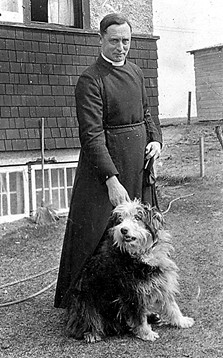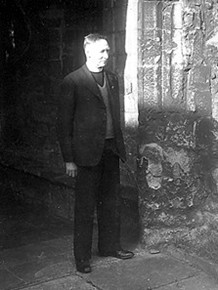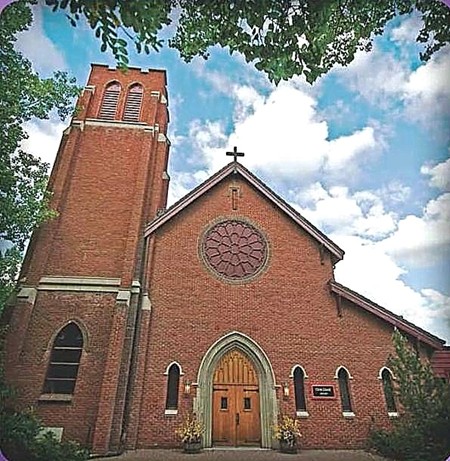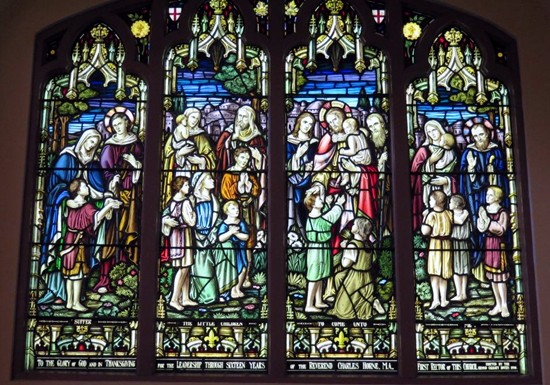A collection of old books, documents and photographs handed in to the Heritage Centre at Bourne for safe keeping in 2015 revealed the life of a past vicar who served this parish for fourteen years and as a pioneer of the scout movement during its early years in Canada. The small archive relating to his life was discovered after the death of a woman who worked as his housekeeper sixty years ago and included a particularly important item, an ebonised walking stick with an embossed silver gilt handle presented to him during this significant part of life. Charles Wynn Ellis Horne was born in 1876 at Hatfield, Hertfordshire, to Henry Horne and his wife, Margaret, who had six other sons and two daughters. He was educated at Clifton College and Bedford Modern School before being admitted to Selwyn House to study for the ministry in 1896 and was awarded a BA degree in 1899 and MA in 1903. He was ordained deacon at Lincoln Cathedral in 1900 and a priest the following year, becoming curate of St John the Divine at Gainsborough and then St Nicholas at Skirbeck from 1903-07. It was at this point of his life that he decided to emigrate under the auspices of the Society for the Propagation of the Gospel and was sent to the province of Calgary in Western Canada where he spent some years doing missionary work. In 1913 he was appointed the first rector of the newly built Christ Church at Calgary where he served for the next sixteen years during which time he was chosen by the bishop for duties at Calgary Cathedral where he was made an honorary canon in 1922. When the Great War began in 1914, he also became a chaplain to the Canadian Armed Forces but it was his work with the boy scouts in which he achieved great prominence. The movement had been founded in England in 1907 by Robert Baden-Powell and soon spread to Canada where the Boy Scout Association was incorporated by an act of parliament in 1914 and is now known as Scouts Canada. While rector of Christ Church, Charles Horne gained a reputation as a great scouter and founded the 2nd Calgary Scout Troop which had such a profound effect on the parish that the east window was installed in his memory. He left Canada because of ill health and returned to England in 1929 when the troop presented him with the walking stick as a mark of their high esteem while the local newspaper gave a glowing tribute to his service with the parish and, more particularly, to the dedication he had devoted to the scouting cause. “Calgary says farewell to a scholar and a leader whose absence will be sorely missed”, said the editorial. “Although naturally an influence for good as a speaker in the pulpit which he occupied, his personality and leadership have extended beyond the sphere of his church and his association with men in community service beyond the walls of his study has left an indelible mark upon the life of this city. “For more than twenty years he has been one of the mainstays of the boy scout movement in this province. In the very early days of this work in Calgary, he was one of the first to appreciate its value and one of those responsible for forming a troop among the choirboys at the cathedral. Thousands of boys, many of whom have since graduated into the professions or who are now actively engaged in the business life of Calgary or the district have come under his leadership during their formative years and have carried with them into the struggle of life no small portion of the ideals of a man whose life has been placed upon the altar of service to his fellow men. Mr Horne will leave Calgary as one of the city’s greatest creditors because its citizens owe him a debt, the payment of which in money would be impossible. He has woven into the moral fabric of this entire community the warp and weft of a better citizenship and he has made Calgary a more pleasant dwelling place for men because he has lived here.” On returning to England he was appointed Vicar of Castle Hedingham, Essex, in 1929 and then moved to Bourne when the living became vacant on the resignation of Canon John Grinter in 1935. The incumbency of the Rev Charles Horne as Vicar of Bourne from 1936-47 was particularly noteworthy because of his work in fostering co-operation between all churches in the town and an indication of his intentions came during his induction at the Abbey Church on Monday 24th February 1936 when he was welcomed by the Rev Denis Brown, superintendent of Bourne and district Free Church Council. “I believe that Mr Horne has come to remove the barriers between the Free Churches and the Church so that they can unite in working for the establishment of the Kingdom of God”, he told the gathering. “They will succeed far better by working together than as individuals.” As a result, the vicar made many friends among all creeds and at special gatherings of the non-conformist churches there was either a message from him or a few words in person and he was always among the first to welcome new ministers when they arrived in town. He was also responsible for re-opening the Eastgate Mission Church in Willoughby Road that had been closed for three years because of a shortage of lay readers, resuming services in August 1936 and promising further support from a newly appointed curate. The vicar was particularly concerned that the building had fallen into disuse, particularly the clubroom at the rear which was equipped with a billiard table and he instructed that it should be repaired in order that it could be fully used by young people, a cause so dear to his heart while working in Canada. But despite his hard work, the vicar was still dogged by failing health and never fully regained his full strength although he continued his ministry at Bourne until 1951 when at the beginning of January, he announced his retirement to take effect the following Easter. The vicar told his congregation that although a return to England had brought some improvement and he had been intensely proud of his preferment as the 15th Vicar of Bourne, he felt unable to continue discharging his duties in the expected manner. His premonition proved to be correct because three months later he was admitted to the Butterfield Hospital in North Road where he died on 4th April 1951, aged 75, and after a funeral service at the Abbey Church he was buried in the town cemetery where a simple tombstone marks his grave. The high altar in the church was later enlarged by a gift in his memory.
NOTE: I am indebted to Suzan Pedersen, parish
administrator at Christ WRITTEN MARCH 2015
Go to: Main Index Villages Index |
||||||||||||||||




